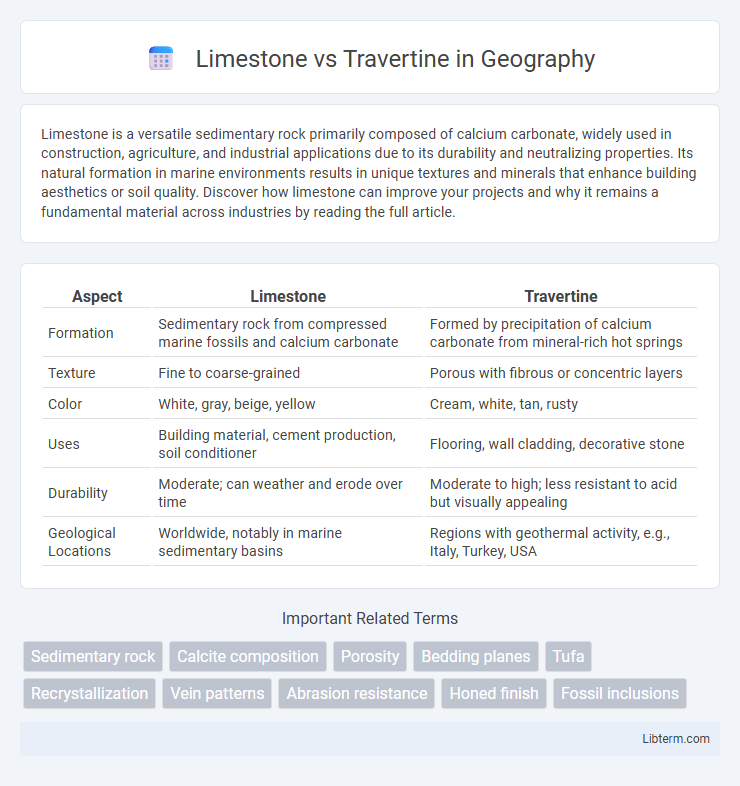Limestone is a versatile sedimentary rock primarily composed of calcium carbonate, widely used in construction, agriculture, and industrial applications due to its durability and neutralizing properties. Its natural formation in marine environments results in unique textures and minerals that enhance building aesthetics or soil quality. Discover how limestone can improve your projects and why it remains a fundamental material across industries by reading the full article.
Table of Comparison
| Aspect | Limestone | Travertine |
|---|---|---|
| Formation | Sedimentary rock from compressed marine fossils and calcium carbonate | Formed by precipitation of calcium carbonate from mineral-rich hot springs |
| Texture | Fine to coarse-grained | Porous with fibrous or concentric layers |
| Color | White, gray, beige, yellow | Cream, white, tan, rusty |
| Uses | Building material, cement production, soil conditioner | Flooring, wall cladding, decorative stone |
| Durability | Moderate; can weather and erode over time | Moderate to high; less resistant to acid but visually appealing |
| Geological Locations | Worldwide, notably in marine sedimentary basins | Regions with geothermal activity, e.g., Italy, Turkey, USA |
Introduction to Limestone and Travertine
Limestone is a sedimentary rock primarily composed of calcium carbonate, formed from marine organisms' skeletal fragments over millions of years, making it a durable and versatile building material. Travertine, a type of limestone, is characterized by its porous texture and is deposited by mineral springs, especially hot springs, resulting in distinctive concentric patterns and natural holes. Both stones are widely used in architecture and interior design for flooring, wall cladding, and decorative elements, valued for their natural beauty and varying levels of hardness.
Geological Formation and Origins
Limestone forms primarily from the accumulation of marine organisms' skeletal fragments, such as coral and mollusks, undergoing compaction and cementation over millions of years in shallow, warm oceans. Travertine originates through chemical precipitation of calcium carbonate from mineral-rich hot springs or groundwater, often exhibiting banded or porous textures due to rapid deposition. Both stones are types of sedimentary carbonate rocks but differ significantly in formation processes and typical environmental settings.
Physical Characteristics Comparison
Limestone exhibits a fine to medium grain texture with a typically uniform, matte surface, while travertine features a fibrous or concentric appearance with natural pits and voids, often requiring filling for smoothness. Limestone is generally denser and less porous, offering higher durability and resistance to weathering compared to the more porous, softer travertine, which absorbs moisture more readily. Both stones display a range of earthy tones, but travertine's banded, layered formation creates unique patterns distinct from limestone's more consistent coloration.
Color and Appearance Differences
Limestone typically exhibits a more uniform, muted color palette with shades ranging from beige and cream to soft grays, often featuring subtle fossilized inclusions that add texture. Travertine presents a more varied and striking appearance, characterized by its natural porous surface and distinctive veins in hues of ivory, gold, rust, and sometimes reddish tones. The presence of natural pits and troughs in travertine gives it a rustic, tactile quality, contrasting limestone's smoother, more consistent finish.
Durability and Strength
Limestone is generally softer and more porous compared to travertine, making travertine more durable and better suited for high-traffic areas. Travertine's natural hardness and density provide enhanced resistance to cracking and wear, which contributes to its longevity in both indoor and outdoor applications. While both materials are sedimentary rocks, travertine's unique formation process results in a tougher stone with greater compressive strength than limestone.
Common Applications in Construction and Design
Limestone is widely used in construction for building facades, flooring, and architectural details due to its durability and ease of carving. Travertine, a type of limestone, is favored in both interior and exterior design for flooring, wall cladding, and bathroom surfaces because of its unique porous texture and natural color variations. Both materials are popular in landscaping and decorative accents, with travertine often chosen for pool surrounds and patios due to its slip-resistant properties.
Maintenance and Care Requirements
Limestone requires regular sealing to prevent staining and is sensitive to acidic cleaners, making pH-neutral cleaning products essential for maintenance. Travertine, a form of limestone with a porous surface, demands more frequent sealing and gentle cleaning to avoid damage from high acidity or abrasive materials. Both stones benefit from prompt spill cleanup and routine dusting to preserve their natural beauty and durability.
Cost and Affordability
Limestone typically offers a more affordable option compared to travertine, with prices ranging from $3 to $7 per square foot for basic installation, making it budget-friendly for large projects. Travertine, known for its durability and unique porous texture, usually costs between $4 and $15 per square foot, reflecting its premium quality and more complex quarrying process. Homeowners and contractors often choose limestone for cost-efficiency, while travertine is preferred for high-end finishes despite the higher investment.
Environmental Impact and Sustainability
Limestone quarrying generally causes moderate environmental disruption due to habitat alteration and dust emissions, while travertine extraction often involves less intensive mining techniques with reduced ecological footprint. Both stones are natural and durable, supporting sustainable building practices through longevity and recyclability, but travertine's formation in hot springs and caves means its extraction must be managed carefully to protect fragile ecosystems. Utilizing locally sourced limestone or travertine minimizes transportation emissions, further enhancing their environmental sustainability profiles.
Choosing the Right Stone: Key Considerations
Limestone offers durability and subtle earthy tones suitable for high-traffic areas, while travertine provides a unique porous texture with natural voids that enhance its aesthetic appeal but may require sealing for protection. Consider the specific application environment, maintenance requirements, and desired visual effect when choosing between limestone's uniform appearance and travertine's intricate patterns. Cost, slip resistance, and weather exposure also play crucial roles in selecting the appropriate stone for both indoor and outdoor installations.
Limestone Infographic

 libterm.com
libterm.com